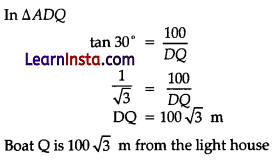Students can access the CBSE Sample Papers for Class 10 Maths Basic with Solutions and marking scheme Set 1 will help students in understanding the difficulty level of the exam.
CBSE Sample Papers for Class 10 Maths Basic Set 1 with Solutions
Maximum Marks: 80
Time Allowed: 3 hours
General Instructions:
1. This Question Paper has 5 Sections A, B, C, D and E.
2. Section A has 20 Multiple Choice Questions (MCQs) carrying1 mark each.
3. Section B has 5 Short Answers-I (SA-I) type questions carrying 2 marks each.
4. Section C has 6 Short Answers-IT (SA-II) type questions carrying 3 marks each
5. Section D has 4 Long Answers (LA) type questions carrying5 marks each.
6. Section E has 3 source based/case based/passage based integrated units of assessment (4 marks each) with sub¬ parts of the values of 1,1 and 2 marks each respectively.
7. All questions are compulsory. However, an internal choice in 2 Qs of 2 marks, 2 Qs of 3 marks and 2 Qs of 5 marks has been given provided. An internal choice has been provided in 2 marks questions of Section E.
8. Draw neat figures wherever required. Take π = 22/7, wherever required if not stated.
Section – A (20 Marks)
Question 1.
If two positive integers a and b are written as a = x3y2 and b = xy3; x, y are prime numbers, then HCF (a, b) is
(A) xy
(B) xy2
(c) x3y3
(D) x2y2
Solution:
(B) xy2
Detailed Answer:
Given that,
⇒ a = x3y2
⇒ b = xy3
HCF (a,b) = xy2
Question 2.
The LCM of smallest two-digit composite number and smallest composite number is
(A) 12
(B) 4
(C) 20
(D) 44
Solution:
(C) 20
Detailed Answer:
We know that, Smallest two-digit composite number = 10
Smallest composite number = 4
We have, LCM (4, 10) = 22 × 5 = 20
Question 3.
Tours of the national capital and the white house begin at 8:30 am from tour agency. Tours for the national capital leave every 15 min. Tours for the white house leave every 20 min. How many minutes after do the tours leave at the same time? 1
(a) 50 min
(b) 60 min
(c) 35 min
(d) 40 min
Answer:
(b) 60 min
Explanation: Required time = LCM (15, 20)
By using prime factorisation method,
15 = 3 × 5
and, 20 = 2 × 2 × 5 = 22 × 5
∴ LCM (15, 20) = 22 × 3 × 5 = 60 mins
In every 60 mins, tour leaves at the same time.
Question 4.
The pair of equations y = 0 and y = – 7 has
(A) One solution
(C) Infinitely many solutions
(B) Two solutions
(D) No solution
Answer:
(D) No solution
Detailed Answer:
Given that,
Pair of linear equations y = 0 and y = -7
We know that, on making the graph of these equations the two lines are parallel to each other and never meet each other.
So, given pair of linear equations does not have any Solution.
Question 5.
Value(s) of k for which the quadratic equation 2x2 – kx + k = 0 has equal roots is
(A) 0 only
(B) 4
(C) 8 only
(D) 0,8
Answer:
(D) 0,8
Detailed Answer:
Given that,
⇒ 2x2 – kx + k = 0
For equal roots, Discriminant = 0 b2 – 4ac
⇒ (-k)2 – 4(2)k = 0
⇒ k2 – 8k = 0
⇒ k(k – 8) = 0
⇒ k = 0, 8
Question 6.
The distance of the point (3, 5) from the X-axis is k units, then k equals
(a) 3
(b) -3
(c) 5
(d) – 5
Answer:
(c) 5
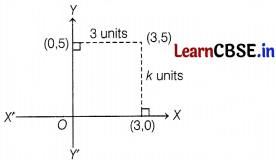
From the graph, we can find, k = 5 units.
Question 7.
If in Δ ABC and Δ PQR, we have \(\frac{A B}{Q R}=\frac{B C}{P R}=\frac{C A}{P Q}\) then,
(A) ΔPQR ∼ ΔACAB
(B) ΔPQR ∼ ΔABC
(C) ΔCBA ∼ ΔPQ
(D) ΔBCA ∼ ΔPQR
Solution:
(A) ΔPQR ∼ ΔACAB
Detailed Answer:
Given that, In triangle ABC and PQR,
⇒ AB/QR = BC/PR = CA/PQ
From the given relation we get, ⇒ PQ/CA = PR/BC = QR/AB
So, triangle PQR ∼ CAB
Question 8.
Which of the following is NOT a similarity criterion of triangles?
(A) AA
(B) SAS
(C) AAA
(D) RHS
Solution:
(D) RHS
Detailed Answer:
RHS is not a similarity criterion, it is a congruence criterion.
Question 9.
The number of revolutions made by a circular wheel of radius 0.7 m in rolling a distance of 176 m is: 1
(a) 22
(b) 24
(c) 75
(d) 40
Answer:
(d) 40
Explanation: Number of revolutions
= \(\frac{\text { total distance }}{\text { circumference }}\)
= \(\frac{176}{2 \times \frac{22}{7} \times 0.7}\)
= 40
Question 10.
If cos A = \(\frac{4}{5}\) then tan A is
(A) \(\frac{3}{5}\)
(B) \(\frac{3}{4}\)
(C) \(\frac{4}{3}\)
(D) \(\frac{1}{8}\)
Solution:
(B) \(\frac{3}{4}\)
Detailed Answer:
Given that,
⇒ Cos A = 4/5
⇒ Sec A = 5/4
⇒ tan2 A = sec2 A – 1
⇒ (5/4)2 – 1 = (3/4)2
⇒ tan A = 3/4
![]()
Question 11.
If the height of the tower is equal to the length of its shadow, then the angle of elevation of the sun is
(A) 30°
(B) 45°
(C) 60°
(D) 90°
Solution:
(B) 45°
Detailed Answer:
Given that,
Height of tower = Length of shadow
Let the angle of elevation be x
⇒ tan x = \(\frac{\text { Height of tower }}{\text { Length of shadow }}\)
⇒ tan x = 1 (tan 45° = 1)
⇒ x = 45°
Question 12.
1 – cos2 A is equal to
(a) sin2 A
(b) tan2 A
(c) 1 – sin2 A
(d) sec2 A
Answer:
(a) sin2 A
We know the trigonometric identity,
sin2 A + cos2 A = 1
⇒ sin2 A = 1 – cos2 A
Question 13.
The radius of a circle is the same as the side of a square. Their perimeters are in the ratio
(A) 1: 1
(B) 2: π
(C) π: 2
(D) √π:2
Solution:
(C) π: 2
Detailed Answer:
Given that,
Radius of circle = Side of square
Let radius of circle be x ⇒ Radius of circle = side of square = x
Ratio of perimeters = \(\frac{\text { Perimeter of circle }}{\text { Perimeter of square }}\)
= 2πx/4x = π/2
Question 14.
The area of the circle is 154 cm2. The radius of the circle is
(A) 7 cm
(B) 14 cm
(C) 3.5 cm
(D) 17.5 cm
Solution:
(A) 7 cm
Detailed Answer:
Given that,
Area of circle = 154 cm2
Let the radius of circle be x πx2 = 154
⇒ x2 = 49
⇒ x = 7 cm
Question 15.
A solid cube is cut into two cuboids of equal volumes. The ratio of surface areas of the given cube and one of the resulting cuboids is: 1
(a) 2 : 3
(b) 1 : 3
(c) 3 : 2
(d) 3 : 1
Answer:
(c) 3 : 2
Explanation: Since the cube is cut into two cuboids of equal volumes, so the two cuboids are equal.

Let the edge of the cube be 2a units and the cube be cut along its length.
∴ Dimensions of each cuboid formed are a × 2a × 2a.
So, surface area of cuboid
= 2 (a × 2a + 2a × 2a + 2a × a)
= 16a2
Also, surface area of cube
= 6(2a)2 = 24a2
∴ Required ratio = 24a2 : 16a2 = 3 : 2.
Question 16.
For the following distribution:

The lower limit of modal class is
(A) 15
(A) 20
(C) 10
(D) 5
Solution:
(A) 15
Detailed Answer:
The class having maximum frequency is 15 – 20
So, Lower limit of modal class is 15
Question 17.
A rectangular sheet of paper 40 cm × 22 cm, is rolled to form a hollow cylinder of height 40 cm. The radius of the cylinder (in cm) is
(A) 3.5
(B) 7
(C) \(\frac{80}{7}\)
(D) 5
Solution:
(A) 3.5
Detailed Answer:
Given that,
Dimensions of rectangular sheet = 40 cm × 22 cm
Height of cylinder = 40 cm
Let radius of cylinder be r
⇒ 2πr = 22
⇒ r = 3.5 cm
![]()
Question 18.
Consider the following frequency distribution
![]()
The median class is
(a) 6 – 12
(b) 12 – 18
(c) 18 – 24
(d) 24 – 30
Answer:
(b) 12 – 18
| Class | Frequency (f) | Cumulative Frequency (cf) |
| 0 – 6 | 12 | 12 |
| 6 – 12 | 10 | 22 |
| 12 – 18 | 15 | 37 |
| 18 – 24 | 8 | 45 |
| 24 – 30 | 11 | 56 |
| Total | n = Xf = 56 | |
\(\frac{n}{2}=\frac{56}{2}\) = 28
Median class is the class whose cumulative frequency is greater than (nearest to) \(\frac{n}{2}\) i.e. 28.
Median class is 12 – 18.
Directions: In the following questions, A Statement of Assertion (A) is followed by a statement of Reason (R).
Mark the correct choice as.
Question 19.
Assertion (A): The point (0, 4) lies on y-axis:
Reason(R): The x coordinate of the point on y-axis is zero
(A) Both assertion (A) and reason (R) are true and reason (R) is the correct explanation of assertion (A).
(B) Both assertion (A) and reason (R) are true but reason (R) is not the correct explanation of assertion (A).
(C) Assertions (A) is true but reason (R) is false.
(D) Assertions (A) is false but reason (R) is true.
Solution:
(A) Both assertion (A) and reason (R) are true and reason (R) is the correct explanation of assertion (A).
Detailed Answer:
Assertion: The point (0, 4) lies on y-axis
Reason: The x-coordinate of the point on y-axis is zero
Hence, both assertion and reason are true and reason is the correct explanation for assertion.
Question 20.
Assertion (A): The HCF of two numbers is 5 and their product is 150. Then their LCM is 40.
Reason(R): For any two positive integers a and b, HCF(a, b) × LCM (a, b) = a × b.
(A) Both assertion (A) and reason (R) are true and reason (R) is the correct explanation of assertion (A).
(B) Both assertion (A) and reason (R) are true but reason (R) is not the correct explanation of assertion (A).
(C) Assertions (A) is true but reason (R) is false.
(D) Assertions (A) is false but reason (R) is true.
Solution:
(D) Assertions (A) is false but reason (R) is true.
Detailed Answer:
Assertion: Given that, HCF = 5
LCM = 40
Product of numbers = 150
We know that, HCF × LCM = Product of numbers
HCF × LCM = 5 × 40 = 200 is not equal to product
So, Assertion is False
Reason: for any two positive integers a and b, HCF (a, b) × LCM (a, b) = a × b.
Hence, Assertion is false but reason is true.
Section – B(10 Marks)
Question 21.
Determine the A.P. whose 3rd term is 5 and the 7th term is 9.
OR
Find the last term of an AP having 9 terms whose last term is 28 and sum of all the terms is 144. 2
Answer:
Here, a3 = a + 2d = 5
and a7 = a + 6d = 9
Solving the two equations, we get
a = 3, d = 1
So, the required A.P. is 3, 4, 5, 6, …………..
OR
Let ‘a’ be the first term of A.P. and ‘d’ be the common difference.
Here, total number of terms of A.P. is 9, i.e. n = 9
nth term = last term = an = a + 8d = 28 …….. (i)
Also, Sn = S9 = \(\frac{9}{2}\)[2a + (9 – 1 )d] = 144
⇒ 9 (a + 4 d) = 144
or 9 a + 36d = 144 ……. (ii)
Solving (i) and (ii) simultaneously, we get
a = 4; d = 3
Thus, the required first term is 4.
Question 22.
In the given figure, if ABCD is a trapezium in which AB||CD|| EF then prove that \(\frac{A E}{E D}=\frac{B F}{F C}\)
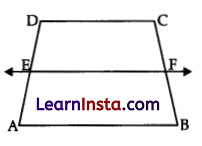
Solution:
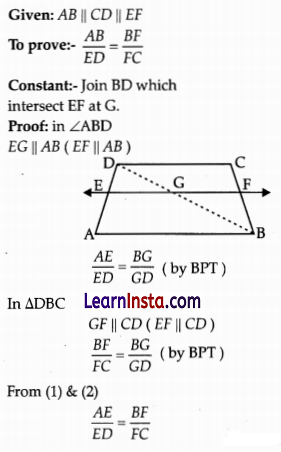
OR
In figure, if AD = 6 cm, DB = 9 cm, AE = 8 cm and EC = 12 cm and ∠ADE = 48°. Find ∠ABC
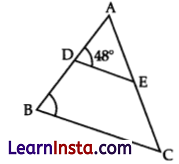
Solution:
Given: AD = 6 cm, DB = 9 cm
AE = 8 cm, EC = 12 cm, ∠ADE = 48°
To find: ∠ABC = ?
Proof: In ΔABC
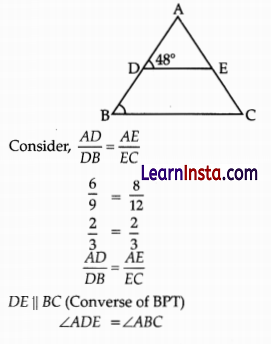
(Corresponding angles) So, ∠ABC=48°
Question 23.
The length of a tangent from a point A at distance 5cm from the centre of the circle is 4cm. Find the radius of the circle.
Solution:
In ΔOTA, ∠OTA = 90°
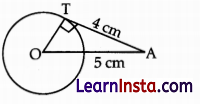
By Pythagoras theorem
OA2 = OT2 + AT2
(5)2 = OT2 + (4)2
25 – 16 = OT2
9 = OT2
OT = 3 cm
radius of circle = 3 cm
Question 24.
Evaluate sin2 60°+ 2 tan 45°- cos2 30°.
Answer:
sin2 60°+ 2 tan 45°- cos2 30°.
= \(\left(\frac{\sqrt{3}}{2}\right)^2\) + 2 (1) + \(\left(\frac{1}{2}\right)^2\)
= \(\frac{3}{4}+2-\frac{1}{4}\)
= \(\frac{2}{4}\) + 2
= \(\frac{1}{2}\) + 2
= \(\frac{5}{2}\)
![]()
Question 25.
Find the diameter of a circle whose area is equal to the sum of the areas of two circles of radii 40cm and 9cm.
Solution:
Area of the circle = sum of areas of 2 circles
πR2 = π(40)2 + π(9)2
πR2 = π × (402 + 92)
R2 = 1600 + 81
R2 = 1681
R = 41 cm.
Diameter of required circle = 41 × 2 = 82cm
OR
A chord of a circle of radius 10cm subtends a right angle at the centre. Find the area of minor segment. (Use π = 3.14)
Solution:
Radius of circle = 10 cm, θ = 90°
Area of mirror segment = \(\frac{\theta}{360^{\circ}}\) πr2 – Area of right angled triangle
= \(\frac{\theta}{360^{\circ}}\) πr2 – 1/2 × b × h
= \(\frac{90^{\circ}}{360^{\circ}}\) × 3.14 × 10 × 10 – 1/2 ×10 × 10
= \(\frac{314}{4}\) – 50
= 78.5 – 50 = 28.5 cm2
Area of minor segment = 28.5 cm2
Section – C(18 Marks)
Question 26.
Prove that A√3 is an irrational number.
Solution:
Let √3 be a rational number
√3 = a/b where and b are co-prime.
(√3)2 = (a/b)2
3 = a2/b2
a2 =3a2
a2 is divisible by 3 so a is also divisible by 3
let a = 3c, for any integer c.
(3c)2 =3b2
9c2 =3b2
b2 = 3c2
since b2 is divisible by 3 so, b is also divisible by 3
From (1) & (2) we can say that 3 is a factor of a and b
which is contradicting the fact that a and b are co-primes.
Thus, our assumption that √3 is a rational number is wrong.
Hence, √3 is an irrational number
Question 27.
There is a circular park of radius 24 m and there is a pole at a distance of 26 m from the centre of the park as shown in the figure. It is planned to enclose the park by planting trees along line segments PQ and PR tangential to the park.

(A) Prove that the length of PQ and PR are equal.
(B) If six trees are to be planted along each tangential line segment at equal distances, find the distance between any two consecutive trees. 3
Answer:
(A) In a right-angled triangle PRO,
We have PR = \(\sqrt{P O^2-R O^2}\)

= \(\sqrt{26^2-24^2}\)
= \(\sqrt{676-576}\)
= \(\sqrt{100}\)
= 10m
⇒ PR = PQ 10m
Hence, proved.
(B) As six trees are to be planted along PQ and PR each.

Let’s assume the distance between consecutive trees is x.
Total trees are at 5 equal distances.
Hence, 5x = 10
x = 2 m
Question 28.
The coach of a cricket team buys 4 bats and 1 ball for ₹ 2050. Later, she buys 3 bats and 2 balls for ₹ 1600. Find the cost of each bat and each ball.
Solution:
Let cost of one bat be ₹ x
Let cost of one ball be ₹ y
ATQ
4x + 1y = 2050 …..(1)
3x + 2y = 1600 …..(2)
from (1) 4x + 1y = 2050
y = 2050 – 4x
Substitute value of y in (2)
[3x + 2(2050 – 4x)= 1600]
3x + 4100 – 8x = 1600
-5x = -2500
x = 500
Substitute value of x in (1)
4x + ly = 2050
4 (500) + y = 2050
2000 + y = 2050
y = 50
Hence
Cost of one bat = ₹ 500
Cost of one ball = ₹ 50
OR
A lending library has a fixed charge for the first three days and an additional charge for each day thereafter. Saritha paid ₹ 27 for a book kept for seven days, while Susy paid ₹ 21 for a book she kept for five days. Find the fixed charge and the charge for each extra day.
Solution:
Let the fixed charge for first 3 days = ₹ x
and additional charge after 3 days = ₹ y
According to given conditions,
x + 4y = 27 …..(1)
x + 2y = 21 …..(2)
Subtract eqn. (2) from (1)
x + 4y = 27
x + 2y = 21
2y =6
y = 3
Substitute value of y in (2)
x + 2y = 21
x + 2(3) = 21
x = 21 – 6
x = 15
Fixed charge = ₹ 15
Additional charge = ₹ 3
![]()
Question 29.
A circle touches all four sides of quadrilateral ABCD. Prove that AB + CD – AD + BC.
Solution:
Given the circle touching sides of quadrilateral ABCD at P, Q, R, and S
To prove: AB + CD = AD + BC
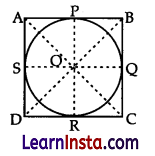
Proof:
AP = AS …(1) tangents from same point
PB = BQ …(2) to a circle are equal in length
DR =DS …(3)
CR = CQ …(4)
Adding eqn (1), (2), (3) & (4)
AP + BP + DR + CR = AS + DS + BQ + CQ
AB + DC = AD + BC
Question 30.
Prove that (cosec θ – cot θ)2 = \(\frac{1-\cos \theta}{1+\cos \theta}\)
Answer:
L.H.S. = (cosec θ – cot θ)2
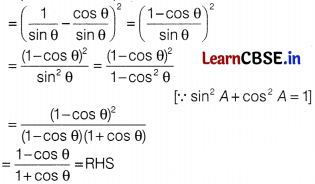
Hence proved.
Or
Prove that sec A (1 – sin A) (sec A + tan A) = 1
Answer:
L.H.S = sec A (1 – sin A) (sec A + tan A)
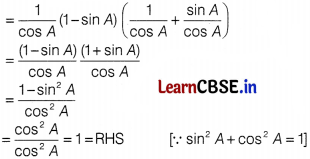
Question 31.
A bag contains 6 red, 4 black and some white balls:
(i) Find the number of white balls in the bag if the probability of drawing a white ball is \(\frac{1}{13}\).
(ii) How many red balls should be removed from the bag for the probability of drawing a white ball to be \(\frac{1}{13}\)?
Solution:
(i) Red balls = 6, Black balls = 4, White balls = x
P(white ball) = \(\frac{x}{10+x}=\frac{1}{3}\)
⇒ 3x = 10 + x ⇒ x = 5 white balls
(ii) Let y red balls be removed, black balls = 4, white balls = 5
P(white balls) = \(\frac{5}{(6-y)+4+5}=\frac{1}{2}\)
⇒ \(\frac{5}{15-y}=\frac{1}{2}\)
⇒ 10 = 15 – y ⇒ y = 5 white balls
So 5 balls should be removed.
Section – D(20 Marks)
Question 32.
A train travels 360 km at a uniform speed. If the speed had been 5km/h more, it would have taken 1 hour less for the same journey. Find the speed of the train.
Solution:
Let the speed of train be x km/hr
distance = 360 km
Speed = \(\frac{\text { distance }}{\text { time }}\)
time = \(\frac{360}{x}\)
New speed = (x + 5) km/hr
Speed = \(\frac{D}{Time}\)
(x + 5) = \(\frac{360}{\left(\frac{360}{x}-1\right)}\)
(x + 5) \(\left(\frac{360}{x}-1\right)\) = 360
(x + 5) (360 – x) = 360 x
-x2 – 5x + 1800 = 0
x2 + 5x – 1800 = 0
x2 + 45x – 40x – 1800 = 0
x (x + 45) – 40 (x + 45) = 0
(x + 45) (x – 40) =0
x + 45= 0, x – 40 =0
x = -45 and x = 40
Speed cannot be negative
Speed of train =40 km/hr
OR
A motor boat whose speed is 18 km/h in still water takes 1 hour more to go 24 km upstream than to return downstream to the same spot. Find the speed of the stream.
Solution:
Let the speed of the stream= x km/hr
Speed of boat= 18 km/hr
Upstream speed= (18 – x) km/hr
Downstream speed =(18 + x) km/hr
Time taken (upstream) = \(\frac{24}{(18-x)}\)
Time taken (downstream) = \(\frac{24}{(18+x)}\)
According to the given conditions,
\(\begin{aligned}
& \frac{24}{(18-x)}=\frac{24}{(18+x)}+1 \\
& \frac{24}{(18-x)}-\frac{24}{(18+x)}=1
\end{aligned}\)
24(18 + x) – 24(18 – x) = (18 – x)(18 + x)
24(18 + x – 18 + x) = (18)2 – (x)2
24(2x) = 324 – x2
48x – 324 + x2 =0
x2 + 48x – 324 =0
x2 – 6x + 54x – 324 =0
x (x – 6) + 54 (x – 6) =0
(x – 6) (x + 54) =0
x – 6 = 0, x + 54 = 0
x = 6 and x = -54
Speed cannot be negative
Speed of stream = 6 km/hr
![]()
Question 33.
Amit and Prem were very good cricketers and also represented their school team at district and even state level. One day, after their match, they measured the height of the wickets and found it to be 28 inches. They marked a point P on the ground as shown in the figure below: 5

(A) If cot P = \(\frac{3}{4}\), then find the length of P.
(B) Find the value of cosec P.
(C) Find the value of \(\frac{1+\sin P}{1+\cos P}\).
(D) Find the value of sec R.
(E) Find the value of cosec2 R – cot2 R.
Answer:
(A) It is given that QR = 28 inches and cot P = \(\frac{3}{4}\)
We know that cot P = \(\frac{\text { Base }}{\text { Perpendicular }}\)
= \(\frac{P Q}{Q R}=\frac{P Q}{28}\)

Therefore, \(\frac{P Q}{28}=\frac{3}{4}\)
⇒ PQ = \(\frac{28 \times 3}{4}\)
= 21 inches.
(B) To evaluate cosec P, we will first find PR by applying Pythagoras theorem in ΔPQR.
PR2 = PQ2 + QR2
= 212 + 282
= 441 + 784
= 1225
⇒ PR = 35 inches
∴ cosec P = \(\frac{\text { Hypotenuse }}{\text { Perpendicular }}\)
= \(\frac{\mathrm{PR}}{\mathrm{QR}}=\frac{35}{28}=\frac{5}{4}\)
Hypotenuse Perpendicular

Question 34.
A medicine capsule is in the shape of a cylinder with two hemispheres stuck at each of its ends. The length of the entire capsule is 14 mm and the diameter of the capsule is 5 mm. Find its surface area.

Solution:
Diameter of cylinder and hemisphere = 5 mm radius(r) = 5/2
Total length = 14 mm
Height of cylinder = 14 – 5 = 9 mm
CSA of cylinder = 2πh
= 2 × \(\frac{22}{7} \times \frac{5}{2}\) × 9

OR
A gulab jamun, contains sugar syrup up to about 30% of its volume. Find approximately how much syrup would be found in 45 gulab jamuns, each shaped like cylinder with two hemispherical ends with length 5 cm and diameter 2.8 cm.
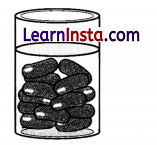
Solution:
Diameter of cylinder = 2.8 cm
Radius of cylinder = 28/2 = 1.4 cm
Radius of cylinder = Radius of hemisphere = 1.4 cm
Height of cylinder = 5 – 2.8 = 2.2 cm
Volume of gulab jamun = vol. of cylinder + 2 × vol. of hemisphere
= πr2h + 2 × 2/3 πr3
= 22/7 × (1.4)3 × 2.2 + 2 × 2/3 × 22/7 × (1.4)3
= 13.55 + 11.50
= 25.05 cm3
volume of 45 gulab jamuns = 45 × 25.05
syrup in 45 jamuns = 30% × 45 × 25.05
= 30/100 × 45 × 25.05
= 338.175 cm3
= 338 cm3
Question 35.
The following table gives the distribution of the life time of 400 neon lamps:
| Life time (in hours) | Number of lamps |
| 1500-2000 | 14 |
| 2000-2500 | 56 |
| 2500-3000 | 60 |
| 3000-3500 | 86 |
| 3500-4000 | 74 |
| 4000-4500 | 62 |
| 4500-5000 | 48 |
Find the average life time of a lamp.
Solution:
| Life time (in hours) | Number of lamps | Mid x | d | Fd |
| 1500-2000 | 14 | 1750 | -1500 | -21000 |
| 2000-2500 | 56 | 2250 | -1000 | -56000 |
| 2500-3000 | 60 | 2750 | -500 | -30000 |
| 3000-3500 | 86 | 3250 | 0 | 0 |
| 3500-4000 | 74 | 3750 | 500 | 30000 |
| 4000-4500 | 62 | 4250 | 1000 | 56000 |
| 4500-5000 | 48 | 4750 | 1500 | 21000 |
| 400 | 64000 |
Using Assumed Mean Method
Mean = a + \(\frac{\sum f d}{\sum f}\)
a = 3250
Mean = 3250 + \(\frac{64000}{400}\)
= 3250 + 160
= 3410
Average life of lamp is 3410 hr
![]()
Section – E(12 Marks)
Question 36.
Case Study 1
India is a competitive manufacturing location due to the low cost of manpower and strong technical and engineering capabilities contributing to higher quality production runs. The production of TV sets in a factory increases uniformly by a fixed number every year. It produced 16000 sets in 6th yr and 22600 in 9th yr.
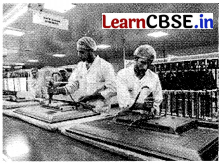
(i) In which year, the production is ₹ 29,200?
Answer:
Let the production increases by d every year
and the production in the 1st yr be a.
Given, production in 6th yr = 16000
⇒ a6 = 16000
a + (6 – 1) d = 16000
a+ 5d = 16000 ………….(i)
Also, production in 9th yr = 22600
⇒ a9 = 22600
a + (9 – 1) d = 22600
a + 8d = 22600 ……………..(ii)
On subtracting Eq. (i) from Eq. (ii), we get
3d = 6600
⇒ d = 2200
a = 5000 [using Eq. (i)]
Let on nth yr. production = 29200
⇒ an = 29200
∴ a + (n – 1) d = 29200
⇒ 5000 + (n – 1) d = 29200
⇒ (n – 1) 2200 = 24200
⇒ n – 1 = 11
⇒ n = 12
In 12th year, the production is 29200.
(ii) Find the production during 8th yr.
Answer:
Production during 8th yr,
a8 = a + 7d
= 5000 + 7 (2200)
= 5000 + 15400
= 20400
Or
Find the production during first 3 yrs.
Answer:
Production during first 3 yr = Production in 1st yr + Production in 2nd yr + Production in 3rd yr
= a1 + a2 + a3
S3 = \(\frac{3}{2}\) [2a + (3 – 1) d]
[∵ Sn = \(\frac{n}{2}\) [2a + (n – 1) d]
= \(\frac{3}{2}\) [2 (5000) + 2 (2200)]
= 3 [5000 + 2200]
= 7200 × 3
= 21600
(iii) Find the difference of the production during 7th yr and 4th yr.
Answer:
a7 – a4 = a- + 6d – (a + 3d)
= 6d – 3d
= 3d
= 3 (2200)
= 6600
Question 37.
Case Study 2
Alia and Shagun are friends living on the same street in Patel Nagar. Shagun’s house is at the intersection of one street with another street on which there is a library. They both study in the same school and that is not far from Shagun’s house. Suppose the school is situated at the point O, i.e., the origin, Alia’s house is at A. Shagun’s house is at B and library is at C.
Based on the above information, answer the following questions.

(i) How far is Alia’s house from Shagun’s house?
(ii) How far is the library from Shagun’s house?
(iii) Show that for Shagun, school is farther compared to Alia’s house and library.
Solution:
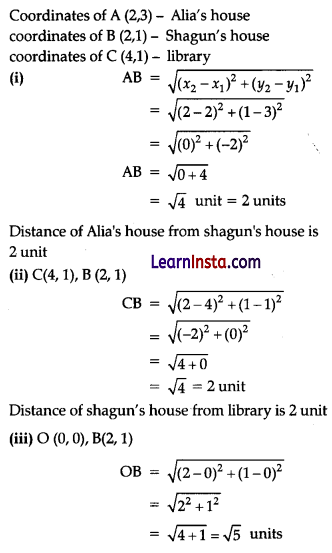
Distance between Alia’s house and Shagun’s house AB = 2 units
Distance between Library and Shagun’s house CB = 2 units
OB is greater than AB and CB,
For shagun, school [O] is farther than Alia’s house [A] and Library [C].
OR
Show that Alia’s house, Shagun’s house and library for an isosceles right triangle.
Solution:
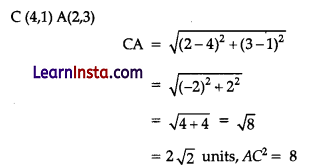
Distance between Alia’s house and Shagun’s house AB = 2 units.
Distance between Library and Shagun’s house CB = 2 units
AB2 + BC2 = 22 + 22 = 4 + 4 = 8 = AC2
Therefore A,B and C form a right triangle.
![]()
Question 38.
Case Study 3
A boy is standing on the top of light house. He observed that boat P and boat Q are approaching the light house from opposite directions. Fie finds that angle of depression of boat P is 45° and angle of depression of boat Q is 30°. He also knows that height of the light house is 100 m.

Based on the above information, answer the following questions.
(i) What is the measure of ∠APD?
(ii) If ∠YAQ = 30°, then ∠AQD is also 30°, Why?
(iii) Find length of PD.
Solution:
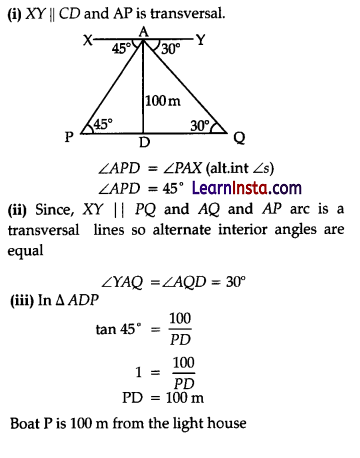
OR
Find length of DQ.
Solution:
